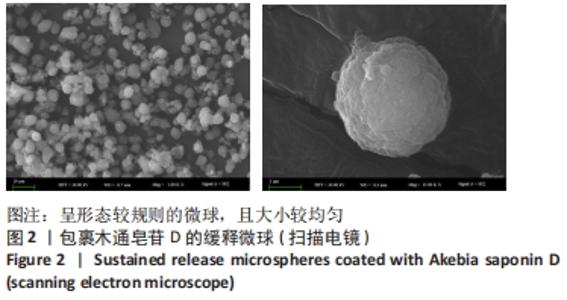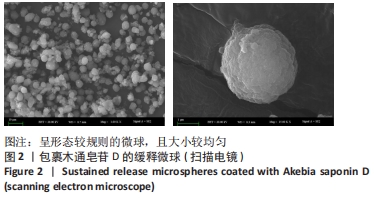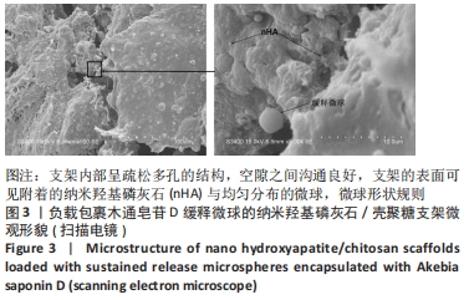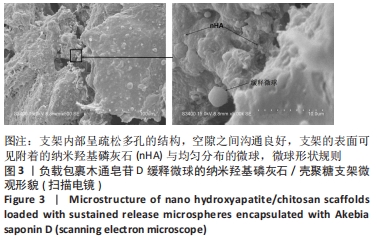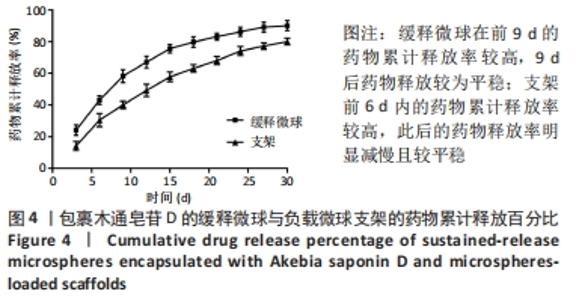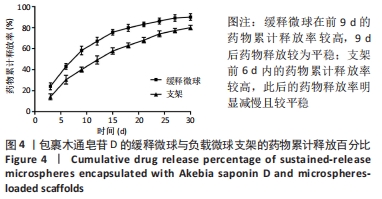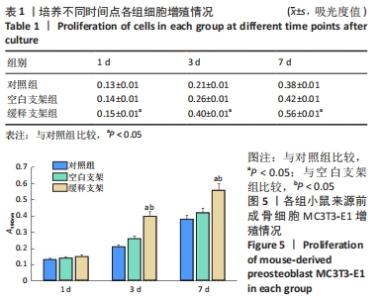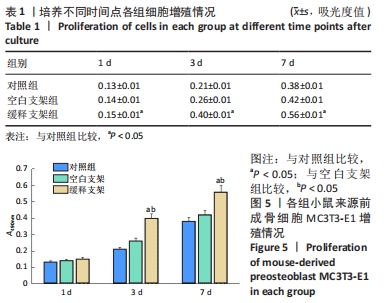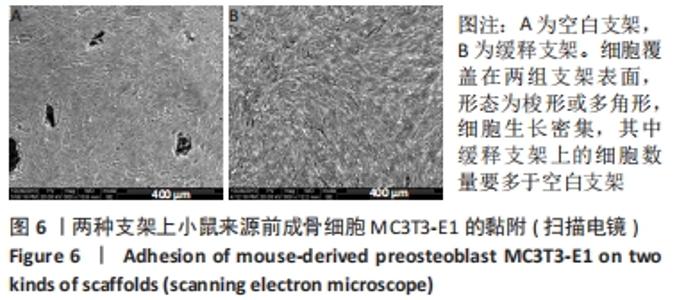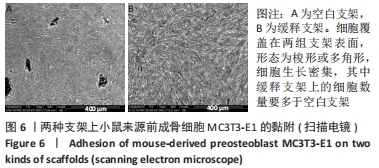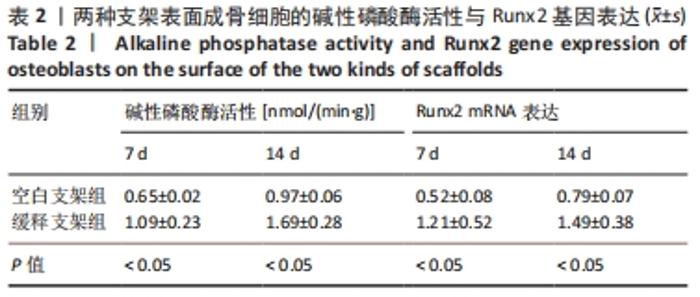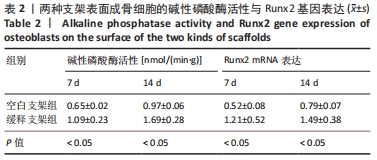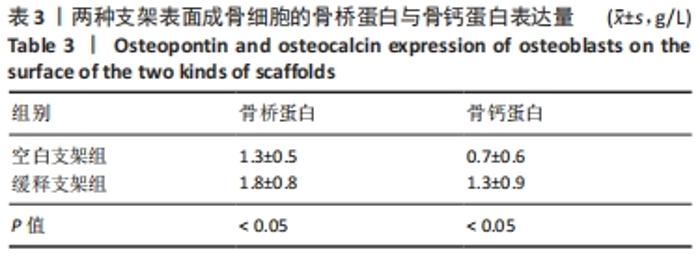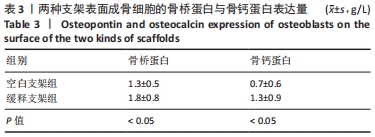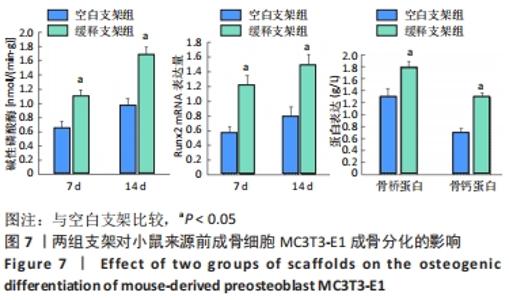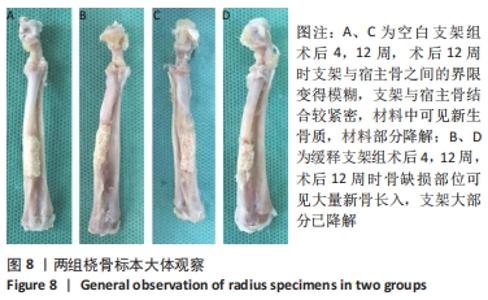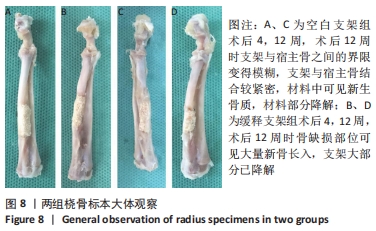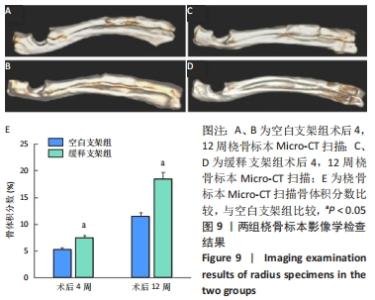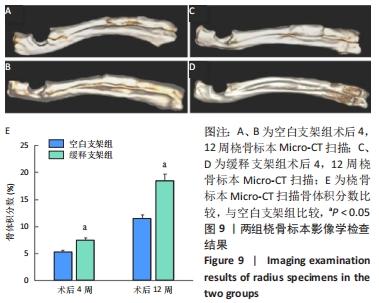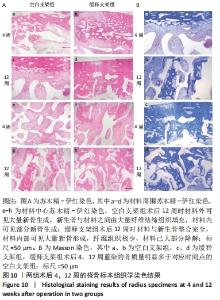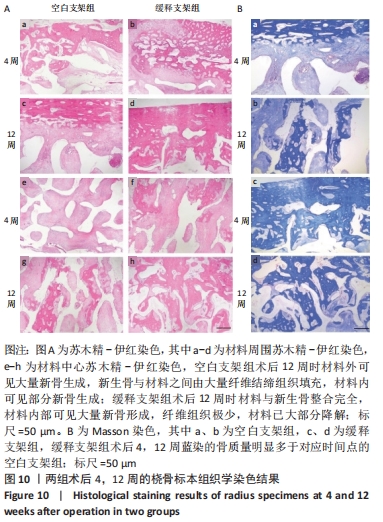Chinese Journal of Tissue Engineering Research ›› 2022, Vol. 26 ›› Issue (27): 4293-4299.doi: 10.12307/2022.858
Previous Articles Next Articles
Nano hydroxyapatite/chitosan scaffold loaded with Akebia saponin D in bone defect repair
Yun Xiao, Ding Tong, Yang Weiqiang, Guo Xinjun
- Department of Orthopedics, Xinxiang Central Hospital, Xinxiang 453000, Henan Province, China
-
Received:2021-04-10Accepted:2021-06-05Online:2022-09-28Published:2022-03-10 -
Contact:Guo Xinjun, Chief physician, Department of Orthopedics, Xinxiang Central Hospital, Xinxiang 453000, Henan Province, China -
About author:Yun Xiao, Attending physician, Master, Department of Orthopedics, Xinxiang Central Hospital, Xinxiang 453000, Henan Province, China
CLC Number:
Cite this article
Yun Xiao, Ding Tong, Yang Weiqiang, Guo Xinjun. Nano hydroxyapatite/chitosan scaffold loaded with Akebia saponin D in bone defect repair[J]. Chinese Journal of Tissue Engineering Research, 2022, 26(27): 4293-4299.
share this article
Add to citation manager EndNote|Reference Manager|ProCite|BibTeX|RefWorks
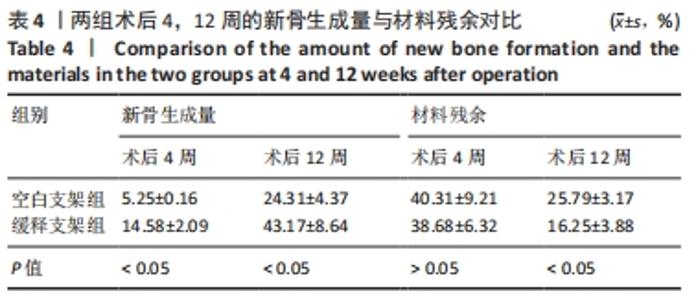
两组术后4,12周的桡骨标本苏木精-伊红染色结果,见图10A。苏木精-伊红染色显示:①空白支架组术后4周时材料周围可见少量的新生骨,材料中心区仅见纤维组织,未见明显新骨形成;术后12周时材料外可见大量新骨生成,新生骨与材料之间由大量纤维结缔组织填充,材料内可见部分新骨生成。②缓释支架组术后4周时在材料周围可见大量小梁状新生骨,新生骨周围环绕着大量的软骨细胞,材料中心区可见大量纤维组织,其中可见少量新生骨区域呈岛状分布;术后12周时材料与新生骨整合完全,材料内部可见大量新骨形成,纤维组织极少,材料已大部分降解。两组术后4,12周的桡骨标本Masson染色染色结果见图10B。Masson染色显示,缓释支架组术后4,12周蓝染的骨质量明显多于对应时间点的空白支架组。对两种染色结果进行统计学分析,缓释支架组术后4,12周的新骨生成量明显多于空白支架组(P < 0.05),术后12周的材料残余量少于空白支架组(P < 0.05),见表4。"
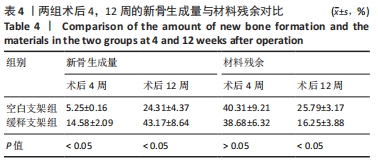
| [1] ZEKRY KM, YAMAMOTO N, HAYASHI K, et al. Reconstruction of intercalary bone defect after resection of malignant bone tumor. J Orthop Surg (Hong Kong). 2019;27(1):2309499019832970. [2] BALDWIN P, LI DJ, AUSTON DA, et al. Autograft, Allograft, and Bone Graft Substitutes: Clinical Evidence and Indications for Use in the Setting of Orthopaedic Trauma Surgery. J Orthop Trauma. 2019;33(4):203-213. [3] LI Y, YANG Y, HUANG Z, et al. Bone defect reconstruction with autologous bone inactivated with liquid nitrogen after resection of primary limb malignant tumors: An observational study. Medicine (Baltimore). 2020;99(24):e20442. [4] LANGER R, VACANTI J. Advances in tissue engineering. J Pediatr Surg. 2016;51(1):8-12. [5] PERIĆ KAČAREVIĆ Ž, RIDER P, ALKILDANI S, et al. An introduction to bone tissue engineering. Int J Artif Organs. 2020;43(2):69-86. [6] MCGOVERN JA, GRIFFIN M, HUTMACHER DW. Animal models for bone tissue engineering and modelling disease. Dis Model Mech. 2018; 11(4):dmm033084. [7] BYAMBAA B, ANNABI N, YUE K, et al. Bioprinted Osteogenic and Vasculogenic Patterns for Engineering 3D Bone Tissue. Adv Healthc Mater. 2017;6(16). doi: 10.1002/adhm.201700015. [8] 王德欣,许战武,裴国献.骨髓间充质干细胞在淫羊藿苷/羟基磷灰石/聚乳酸-羟基乙酸共聚物支架上的成骨[J].中国组织工程研究,2020,24(25):3974-3980. [9] 宁钰,秦文,任亚辉,等.载淫羊藿苷/凹凸棒石/Ⅰ型胶原/聚己内酯复合支架修复兔胫骨缺损的实验研究[J].中国修复重建外科杂志,2019,33(9):1181-1189. [10] DENG Z, CHEN J, LIN B, et al. A novel 3D printed bioactive scaffolds with enhanced osteogenic inspired by ancient Chinese medicine HYSA for bone repair. Exp Cell Res. 2020;394(2):112139. [11] 谢瑾玉,邓晓红,孙贤俊,等.续断水提液诱导HeLa细胞的凋亡[J].中成药,2017,39(12):2595-2599. [12] WANG Y, SHEN J, YANG X, et al. Akebia saponin D reverses corticosterone hypersecretion in an Alzheimer’s disease rat model. Biomed Pharmacother. 2018;107:219-225. [13] YU X, WANG LN, MA L, et al. Akebia saponin D attenuates ibotenic acid-induced cognitive deficits and pro-apoptotic response in rats: involvement of MAPK signal pathway. Pharmacol Biochem Behav. 2012; 101(3):479-486. [14] LI C, LIU Z, TIAN J, et al. Protective roles of Asperosaponin VI, a triterpene saponin isolated from Dipsacus asper Wall on acute myocardial infarction in rats. Eur J Pharmacol. 2010;627(1-3):235-241. [15] 田欢,赵锋,李晔,等.川续断皂苷Ⅵ的研究进展[J].中国实验方剂学杂志,2018,24(5): 226-234. [16] 张志达,沈耿杨,任辉,等.木通皂苷D促进糖皮质激素环境下小鼠骨髓间充质干细胞成骨分化[J].中国骨质疏松杂志,2020,26(4): 529-533. [17] 陈佩佩,王旭霞,王媛,等.川续断皂苷VI对大鼠正畸牙周组织改建影响的研究[J].口腔医学,2018,38(5): 410-416 [18] 郝贵周,杜丽平,周苗苗,等.不同盐型对加兰他敏缓释微球性能影响的初步考察[J].中国医药工业杂志,2020,51(8):1017-1023. [19] 荆玲,范炎峰,邹梦梦,等.延胡索乙素聚乳酸纳米粒的制备及其体内药动学研究[J].中成药,2021,43(3):579-584. [20] 温玉莹,钟燕南,梁佳欣,等.红景天苷-胶原蛋白海绵支架的构建及其对大鼠皮肤创伤的修复作用[J].广西医学,2020,42(13): 1669-1673. [21] 魏松乔,郭澍,佟爽,等.脂肪干细胞-丝素/壳聚糖支架复合物在外泌体诱导下的体外成骨效应[J].中国医科大学学报,2019,48(10): 891-895. [22] 郭小双,蒋海越,宋国栋,等.双相生物钙磷陶瓷生物相容性及异位骨诱导的实验研究[J].中华整形外科杂志,2021,37(1):94-102. [23] 孙仁凇,张建斌,房佳霓,等.壳聚糖纳米粒作为药物递送系统在癌症治疗中的应用[J].中国临床药理学与治疗学,2021,26(1):65-75. [24] PREETHI SOUNDARYA S, HARITHA MENON A, VIJI CHANDRAN S, et al. Bone tissue engineering: Scaffold preparation using chitosan and other biomaterials with different design and fabrication techniques. Int J Biol Macromol. 2018;119:1228-1239. [25] CUI ZK, KIM S, BALJON JJ, et al. Microporous methacrylated glycol chitosan-montmorillonite nanocomposite hydrogel for bone tissue engineering. Nat Commun. 2019;10(1):3523. [26] DEMIRTAŞ TT, IRMAK G, GÜMÜŞDERELIOĞLU M. A bioprintable form of chitosan hydrogel for bone tissue engineering. Biofabrication. 2017; 9(3):035003. [27] LAVANYA K, CHANDRAN SV, BALAGANGADHARAN K, et al. Temperature- and pH-responsive chitosan-based injectable hydrogels for bone tissue engineering. Mater Sci Eng C Mater Biol Appl. 2020;111:110862. [28] PENG XY, HU M, LIAO F, et al. La-Doped mesoporous calcium silicate/chitosan scaffolds for bone tissue engineering. Biomater Sci. 2019;7(4): 1565-1573. [29] 梁志豪.纳米羟基磷灰石-壳聚糖支架复合外周血间充质干细胞修复大鼠胫骨缺损的实验研究[D].广州:南方医科大学,2017. [30] MOHAMMED EEA, BEHEREI HH, EL-ZAWAHRY M, et al. Combination of Human Amniotic Fluid Derived-Mesenchymal Stem Cells and Nano-hydroxyapatite Scaffold Enhances Bone Regeneration. Open Access Maced J Med Sci. 2019;7(17):2739-2750. [31] HE Y, DONG Y, CUI F, et al. Ectopic osteogenesis and scaffold biodegradation of nano-hydroxyapatite-chitosan in a rat model. PLoS One. 2015;10(8):e0135366. [32] PUCKERT C, TOMASKOVIC-CROOK E, GAMBHIR S, et al. Molecular interactions and forces of adhesion between single human neural stem cells and gelatin methacrylate hydrogels of varying stiffness. Acta Biomater. 2020;106:156-169. [33] 崔学文,陆浩,吕德民,等.SHH修饰聚多巴胺涂层纤维蛋白支架对大鼠神经干细胞的影响[J].神经解剖学杂志,2020,36(1):15-22. [34] 刘艺萍,王珏,田子璐,等.支架微观形貌和力学性能对管状牙本质再生的影响[J].华西口腔医学杂志,2020,38(3):314-318. [35] ZHAO MD, HUANG JS, ZHANG XC, et al. Construction of Radial Defect Models in Rabbits to Determine the Critical Size Defects. PLoS One. 2016;11(1):e0146301. [36] GEIGER F, LORENZ H, XU W, et al. VEGF producing bone marrow stromal cells (BMSC) enhance vascularization and resorption of a natural coral bone substitute. Bone. 2007;41:516-522. [37] BECK A, WOODS S, LANSDOWNE JL, et al. The effects of multiple highresolution peripheral quantitative computed tomography scans on bone healing in a rabbit radial bone defect model. Bone. 2013;56:312-319. |
| [1] | Yao Xiaoling, Peng Jiancheng, Xu Yuerong, Yang Zhidong, Zhang Shuncong. Variable-angle zero-notch anterior interbody fusion system in the treatment of cervical spondylotic myelopathy: 30-month follow-up [J]. Chinese Journal of Tissue Engineering Research, 2022, 26(9): 1377-1382. |
| [2] | Wang Ruanbin, Cheng Liqian, Chen Kai. Application and value of polymer materials in three-dimensional printing biological bones and scaffolds [J]. Chinese Journal of Tissue Engineering Research, 2022, 26(4): 610-616. |
| [3] | Li Hui, Chen Lianglong. Application and characteristics of bone graft materials in the treatment of spinal tuberculosis [J]. Chinese Journal of Tissue Engineering Research, 2022, 26(4): 626-630. |
| [4] | Tan Guozhong, Tu Xinran, Guo Liyang, Zhong Jialin, Zhang Yang, Jiang Qianzhou. Biosafety evaluation of three-dimensional printed gelatin/sodium alginate/58S bioactive glass scaffolds for bone defect repair [J]. Chinese Journal of Tissue Engineering Research, 2022, 26(4): 521-527. |
| [5] | Le Guoping, Zhang Ming, Xi Licheng, Luo Hanwen. Preparation and in vitro evaluation of vancomycin hydrochloride@polylactic acid-glycolic acid copolymer-chitosan-hyaluronic acid composite sustained-release microspheres [J]. Chinese Journal of Tissue Engineering Research, 2022, 26(4): 528-534. |
| [6] | He Yunying, Li Lingjie, Zhang Shuqi, Li Yuzhou, Yang Sheng, Ji Ping. Method of constructing cell spheroids based on agarose and polyacrylic molds [J]. Chinese Journal of Tissue Engineering Research, 2022, 26(4): 553-559. |
| [7] | He Guanyu, Xu Baoshan, Du Lilong, Zhang Tongxing, Huo Zhenxin, Shen Li. Biomimetic orientated microchannel annulus fibrosus scaffold constructed by silk fibroin [J]. Chinese Journal of Tissue Engineering Research, 2022, 26(4): 560-566. |
| [8] | Chen Xiaoxu, Luo Yaxin, Bi Haoran, Yang Kun. Preparation and application of acellular scaffold in tissue engineering and regenerative medicine [J]. Chinese Journal of Tissue Engineering Research, 2022, 26(4): 591-596. |
| [9] | Kang Kunlong, Wang Xintao. Research hotspot of biological scaffold materials promoting osteogenic differentiation of bone marrow mesenchymal stem cells [J]. Chinese Journal of Tissue Engineering Research, 2022, 26(4): 597-603. |
| [10] | Guan Jian, Jia Yanfei, Zhang Baoxin , Zhao Guozhong. Application of 4D bioprinting in tissue engineering [J]. Chinese Journal of Tissue Engineering Research, 2022, 26(3): 446-455. |
| [11] | Shen Zhen, Guo Ying, Jiang Ziwei, Zhang Yan, Li Zige, Chen Zehua, Ye Xiangling, Chen Guoqian. Comparison of the effects between two routes of total flavones of Rhizoma Drynariae administration on large segmental bone defects in rats based on bone tissue engineering technique [J]. Chinese Journal of Tissue Engineering Research, 2022, 26(27): 4346-4352. |
| [12] | Liu Yin, Liu Qin, Chen Jiao, Gu Xianyang, Chen Jiawen, Ma Minxian. Properties of injectable gluconolactone-sodium alginate/beta-tricalcium phosphate/polyethylene glycol composite hydrogel scaffold [J]. Chinese Journal of Tissue Engineering Research, 2022, 26(27): 4308-4313. |
| [13] | Zheng Haisheng, Lan Yuqing, Zhong Xingwu, Ding Hui. Effect of curcumin nanoparticles on proliferation of human retinal pigment epithelial cells [J]. Chinese Journal of Tissue Engineering Research, 2022, 26(27): 4335-4339. |
| [14] | Zhao Doudou, Lin Kaili. Application of multicellular construction of vascularized tissue engineered bone in bone repair [J]. Chinese Journal of Tissue Engineering Research, 2022, 26(27): 4386-4392. |
| [15] | Xu Ran, Chen Xingyu, Li Zhiqiang. Antibacterial agents loaded on hydroxyapatite scaffolds: action mechanism between the drug and the scaffold [J]. Chinese Journal of Tissue Engineering Research, 2022, 26(27): 4411-4416. |
| Viewed | ||||||
|
Full text |
|
|||||
|
Abstract |
|
|||||
